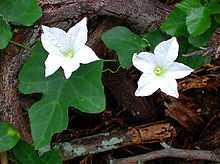Coccinia
| Coccinia | |
|---|---|
 | |
| Coccinia grandis | |
| Scientific classification | |
| Kingdom: | Plantae |
| (unranked): | Angiosperms |
| (unranked): | Eudicots |
| (unranked): | Rosids |
| Order: | Cucurbitales |
| Family: | Cucurbitaceae |
| Subfamily: | Cucurbitoideae |
| Tribe: | Benincaseae |
| Subtribe: | Benincasinae |
| Genus: | Coccinia Wight & Arn. |
| Species | |
| |
| Synonyms | |
| |
The Scarlet gourds (Coccinia) is a genus with 28-30 species.[1] It is distributed in sub-Saharan Africa and with one species in South and Southeast Asia that is also introduced into the New World. It is best known for the cultivated crop C. grandis, the Ivy gourd.
Coccinia is the transliteration from the Greek, Kokkinia or Kokkinias ~ "red" or "scarlet." Further research has revealed that "kokkino" was also used in Classical Greek to mean scarlet. Evidently the word derived from a kermesberry, used to dye cloth scarlet. In Ancient Greek is was ἐρυθρός (eruthrós).
References
- ↑ Holstein, N., and S. S. Renner. 2011. A dated phylogeny and collection records reveal repeated biome shifts in the African genus Coccinia (Cucurbitaceae). BMC Evolutionary Biology 11: 28. online
External links
- Dressler, S.; Schmidt, M. & Zizka, G. (2014). [http://www.africanplants.senckenberg.de/root/index.php?submitForm=true&page_id=77&searchTextMenue=Coccinia&filterRegionIDs[]=6&filterRegionIDs[]=1&filterRegionIDs[]=2&filterRegionIDs[]=3&filterRegionIDs[]=5 "Coccinia"]. African plants – a Photo Guide. Frankfurt/Main: Forschungsinstitut Senckenberg.